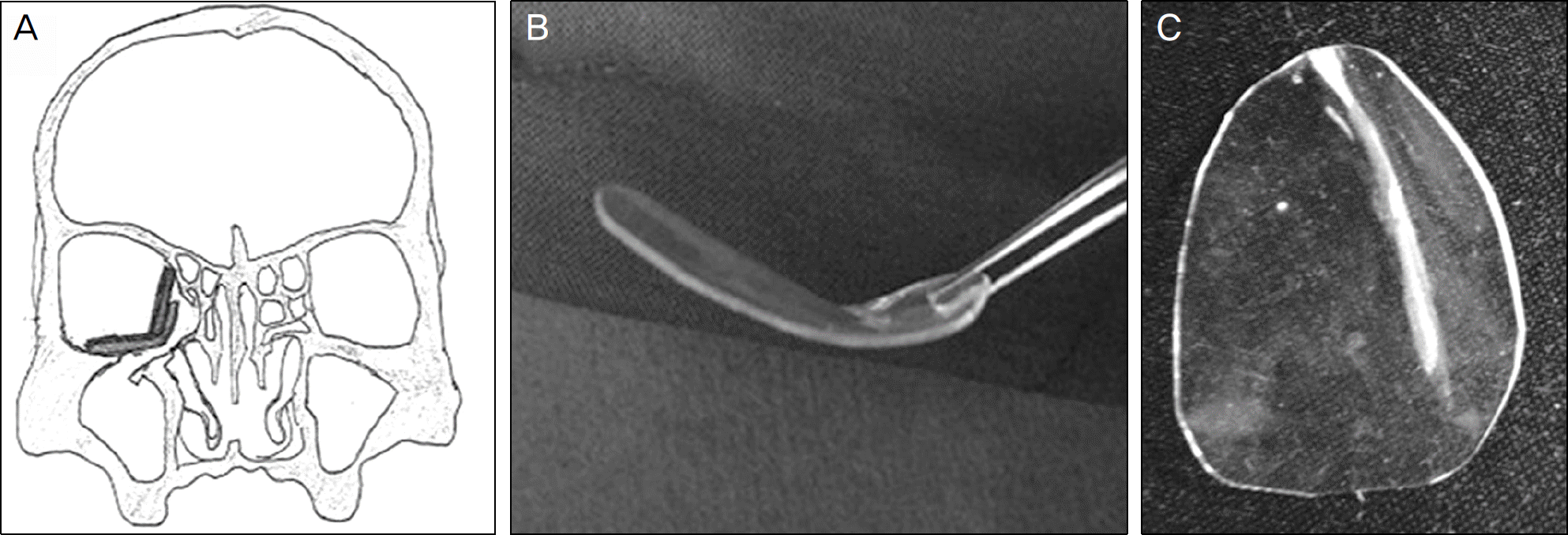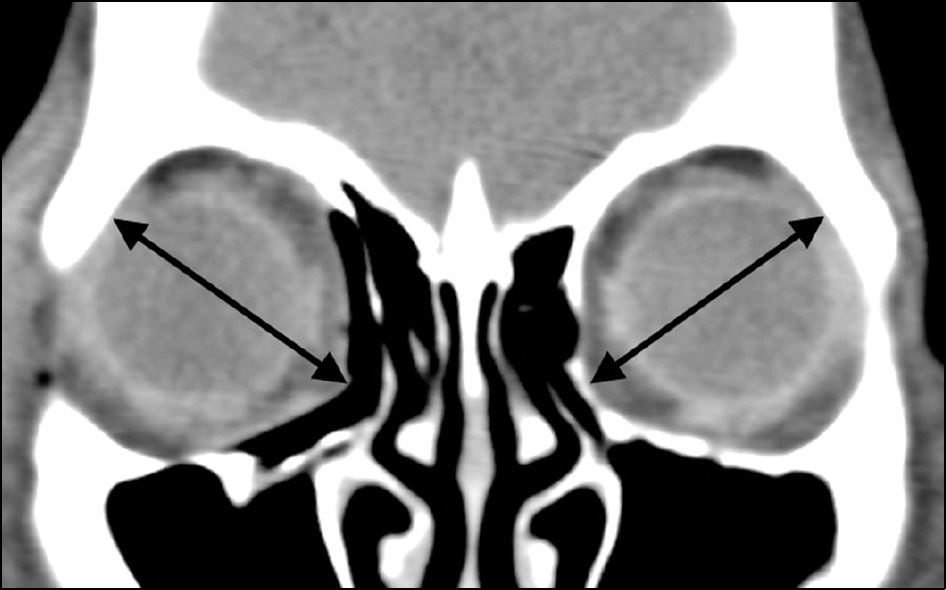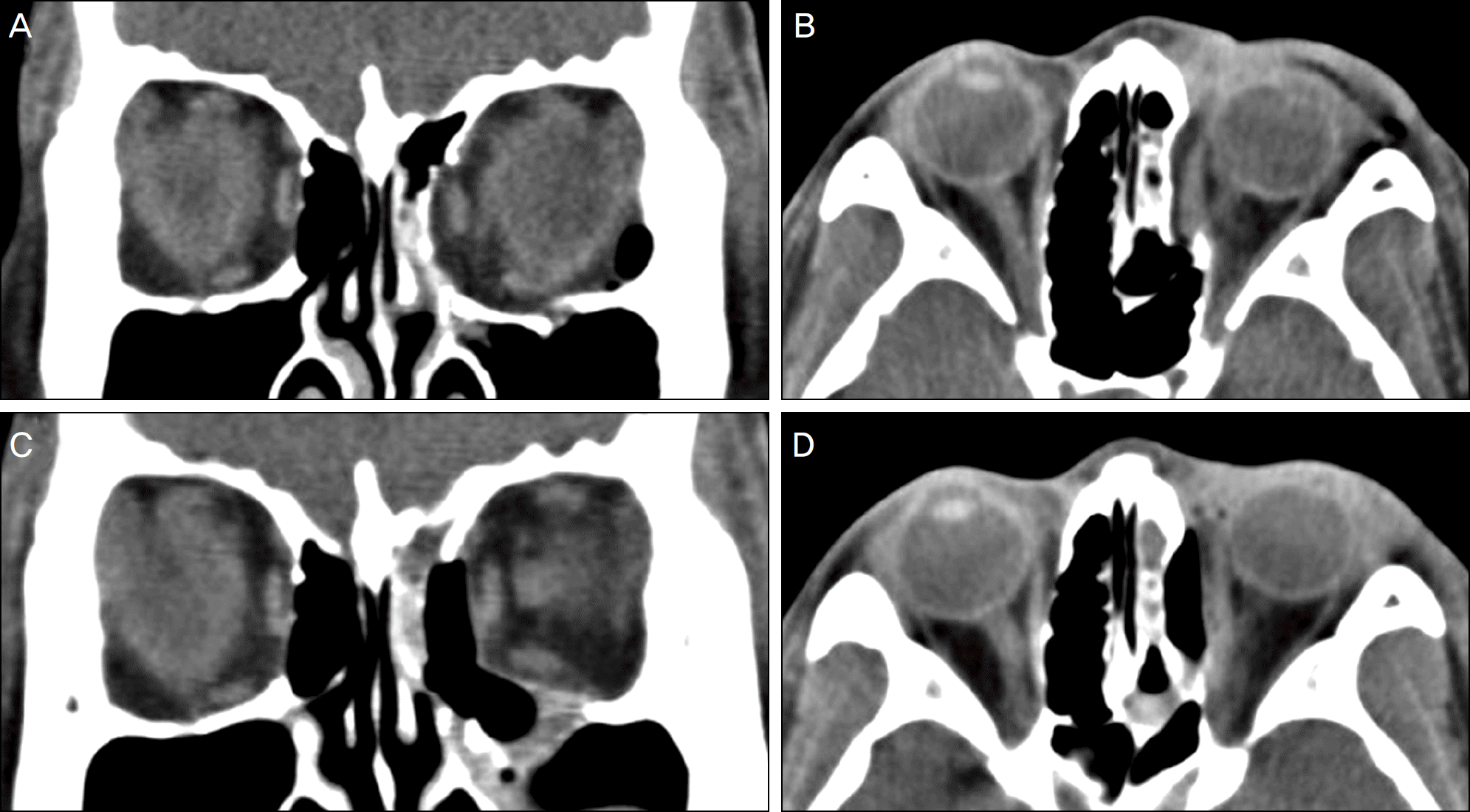Abstract
Purpose
To report the results of surgical repairing of inferomedial orbital wall fractures accompanied with loss of bony strut by an overlapping method using Resorb X® plates (poly(D,L)-lactic acid).
Methods
To repair inferomedial orbital wall fractures with loss of bony strut, we bent the medial aspect of the plate for floor fracture according to the anatomical structure and then inserted the floor implant, which was supported by anterior, posteri-or and lateral margins of the floor fracture. Then, the medial implant, which was supported by the bent medial edge of the floor implant, was inserted. Postoperatively, we analyzed the outcomes of 21 patients regarding postoperative enoph-thalmos, limitation of eye movement (LOM) and diplopia. The diagonal lengths of the orbit in the operated side were com-pared with the non-traumatized side based on the coronal view of the postoperative CT scans to determine the success or failure of the reconstruction.
Results
The average postoperative enophthalmic value was 0.5 mm, and no significant differences between the orbital di-agonal lengths of the operated and non-operated eyes were observed. The LOM shown in 7 out of 8 patients was com-pletely resolved during the postoperative follow-up period. All patients with diplopia, including one patient who showed par-tial remission of LOM, experienced complete symptom resolution. No other complications related to the implant were recorded.
References
1. Yano H, Nakano M, Anraku K. . A consecutive case review of orbital blowout fractures and recommendations for comprehensive management. Plast Reconstr Surg. 2009; 124:602–11.

2. Shi W, Jia R, Li Z. . Combination of transorbital and endo-scopic transnasal approaches to repair orbital medial wall and floor fractures. J Craniofac Surg. 2012; 23:71–4.

3. Jeon C, Shin JH, Woo KI, Kim YD. Porous polyethylene/ Titanium implants in the treatment of large orbital fractures. J Korean Ophthalmol Soc. 2009; 50:1133–40.
4. Lim HS, Kook KH. Results of reconstruction of orbital wall fracture with bioresorbable plate. J Korean Ophthalmol Soc. 2009; 50:1761–7.

5. Yoon JS, Chung SA, Lee SY. Repair of large posterior inferior wall fracture using Medpor(R) channel sheet implant. J Korean Ophthalmol Soc. 2006; 47:1217–24.
6. Lieger O, Schaller B, Zix J. . Repair of orbital floor fractures using bioresorbable poly-L/DL-lactide plates. Arch Facial Plast Surg. 2010; 12:399–404.

7. Chi MJ, Jeung JW, Lee JH. Reconstruction of orbital wall fracture with resorbable copolymer mesh. J Korean Ophthalmol Soc. 2006; 47:1021–30.
8. Dolman PJ, Cahill K, Czyz CN. . Reliability of estimating ductions in thyroid eye disease: an International Thyroid Eye Disease Society multicenter study. Ophthalmology. 2012; 119:382–9.
9. Park HS, Kim YK, Yoon CH. Various applications of titanium mesh screen implant to orbital wall fractures. J Craniofac Surg. 2001; 12:555–60.

10. Scales JT. Discussion on metals and synthetic materials in relation to soft tissue: Tissue’s reaction to synthetic materials. Proc R Soc Med. 1953; 46:647–50.
11. Kim HK, Lim HS, Chung WS. Surgical effect of Medpor in the re-construction of orbital wall fracture. J Korean Ophthalmol Soc. 1998; 39:623–30.
12. Villarreal PM, Monje F, Morillo AJ. . Porous polyethylene im-plants in orbital floor reconstruction. Plast Reconstr Surg. 2002; 109:877–85. discussion 886-7.

13. Mauriello JA Jr, Wasserman B, Kraut R. Use of vicryl (polyglactin-910) mesh implant for repair of orbital floor fracture causing diplopia: a study of 28 patients over 5 years. Ophthal Plast Reconstr Surg. 1993; 9:191–5.
14. Burres SA, Cohn AM, Mathig RH. Repair of orbital blowout fractures with Marlex mesh and Gelfilm. Laryngoscope. 1981; 91:1881–6.

15. Iizuka T, Mikkonen P, Paukku P. . Reconstruction of orbital floor with polydioxanoneplate. Int J Oral Maxillofac Surg. 1991; 20:83–7.
Figure 1.
(A) Schematic drawing of overlapping method for repairing of floor and medial wall fractures with loss of bony strut. (B), (C) Note the bended portion of floor implant to support the medial implant instead of the bony strut.

Figure 2.
The maximal diagonal lengths of the orbit in the op-erated and non-operated eye were measured from the point of supero-lateral orbital edge to the bony strut.

Figure 3.
Preoperative and post operative computed tomography images for repair of a combined infero-medial orbital wall fracture with loss of bony strut by an overlapping method. (A) Preoperative coronal view (B) Preoperative axial view (C) Postoperative coro-nal view. Note the similar size of the “box-shaped” orbit in both eyes (D) Postoperative axial view.

Table 1.
Demographic data of patients
| Sex | Age (year) | Dur*(day) | F/U†(month) |
Diplopia |
LOM∏ |
Enophthalmos (mm) |
Diagonal length of orbit (mm) |
|||||
|---|---|---|---|---|---|---|---|---|---|---|---|---|
| Pre‡ | Post§ | Pre‡ | Post§ | Pre‡ | Post§ | Operated | Contralateral | |||||
| 1 | F | 25 | 19 | 22 | ‐ | ‐ | ‐ | ‐ | 0.5 | 1.0 | 37.44 | 37.73 |
| 2 | F | 29 | 11 | 18 | + | ‐ | ‐ | ‐ | 1.0 | 0.0 | 36.46 | 36.26 |
| 3 | M | 50 | 31 | 7 | ‐ | ‐ | ‐ | ‐ | 2.5 | 1.5 | 36.26 | 36.21 |
| 4 | M | 14 | 58 | 10 | ‐ | ‐ | ‐ | ‐ | 2.0 | 0.0 | 36.15 | 36.18 |
| 5 | M | 36 | 24 | 1 | + | ‐ | ‐ | ‐ | 2.0 | 0.5 | 42.64 | 42.61 |
| 6 | M | 30 | 0 | 2 | + | ‐ | Mod | ‐ | 0.5 | 1.0 | 38.94 | 38.67 |
| 7 | M | 16 | 21 | 21 | ‐ | ‐ | ‐ | ‐ | 2.0 | 0.5 | 38.94 | 38.67 |
| 8 | M | 51 | 106 | 1 | ‐ | ‐ | ‐ | ‐ | 2.0 | 0.0 | 35.00 | 34.94 |
| 9 | F | 28 | 24 | 3 | ‐ | ‐ | Mod | ‐ | 2.0 | 1.0 | 35.00 | 34.95 |
| 10 | F | 19 | 16 | 3 | + | ‐ | Mild | ‐ | 2.0 | 0.0 | 35.54 | 35.59 |
| 11 | M | 60 | 9 | 4 | ‐ | ‐ | Mod | ‐ | 2.0 | 0.0 | 34.63 | 34.70 |
| 12 | M | 24 | 19 | 18 | ‐ | ‐ | ‐ | ‐ | 1.0 | 1.0 | 36.15 | 36.65 |
| 13 | M | 32 | 31 | 9 | + | ‐ | ‐ | ‐ | 0.0 | 0.0 | 33.14 | 33.77 |
| 14 | M | 16 | 20 | 3 | ‐ | ‐ | ‐ | ‐ | 2.0 | 0.0 | 34.61 | 34.27 |
| 15 | M | 32 | 4 | 7 | + | ‐ | Sev | Mild | 1.0 | 1.0 | 36.25 | 36.47 |
| 16 | M | 10 | 18 | 5 | + | ‐ | ‐ | ‐ | 0.5 | 0.5 | 36.02 | 36.04 |
| 17 | M | 37 | 17 | 1 | ‐ | ‐ | ‐ | ‐ | 3.0 | 1.5 | 38.63 | 38.48 |
| 18 | M | 22 | 23 | 2 | ‐ | ‐ | ‐ | ‐ | 1.5 | 0.0 | 36.24 | 36.05 |
| 19 | M | 27 | 16 | 12 | + | ‐ | Mod | ‐ | 1.0 | 0.0 | 34.63 | 34.81 |
| 20 | M | 19 | 23 | 4 | + | ‐ | Sev | ‐ | 1.5 | 0.0 | 35.36 | 35.58 |
| 21 | F | 53 | 23 | 2 | + | ‐ | Mild | ‐ | 1.5 | 1.0 | 34.47 | 34.33 |
| Mean | n | 30.0 | 24.4 | 7.4 | 1.5 | 0.5 | 36.31 | 36.33 | ||||
∏ Light target is held directly in front of subject's eye as the patient is asked to look as far as possible in the corresponding directions (Sev: light reflex (LR) falls inside pupil, Mod: LR falls near to pupil margin between limbus and pupil margin, Mild: LR falls near to limbus between limbus and pupil margin).




 PDF
PDF ePub
ePub Citation
Citation Print
Print


 XML Download
XML Download